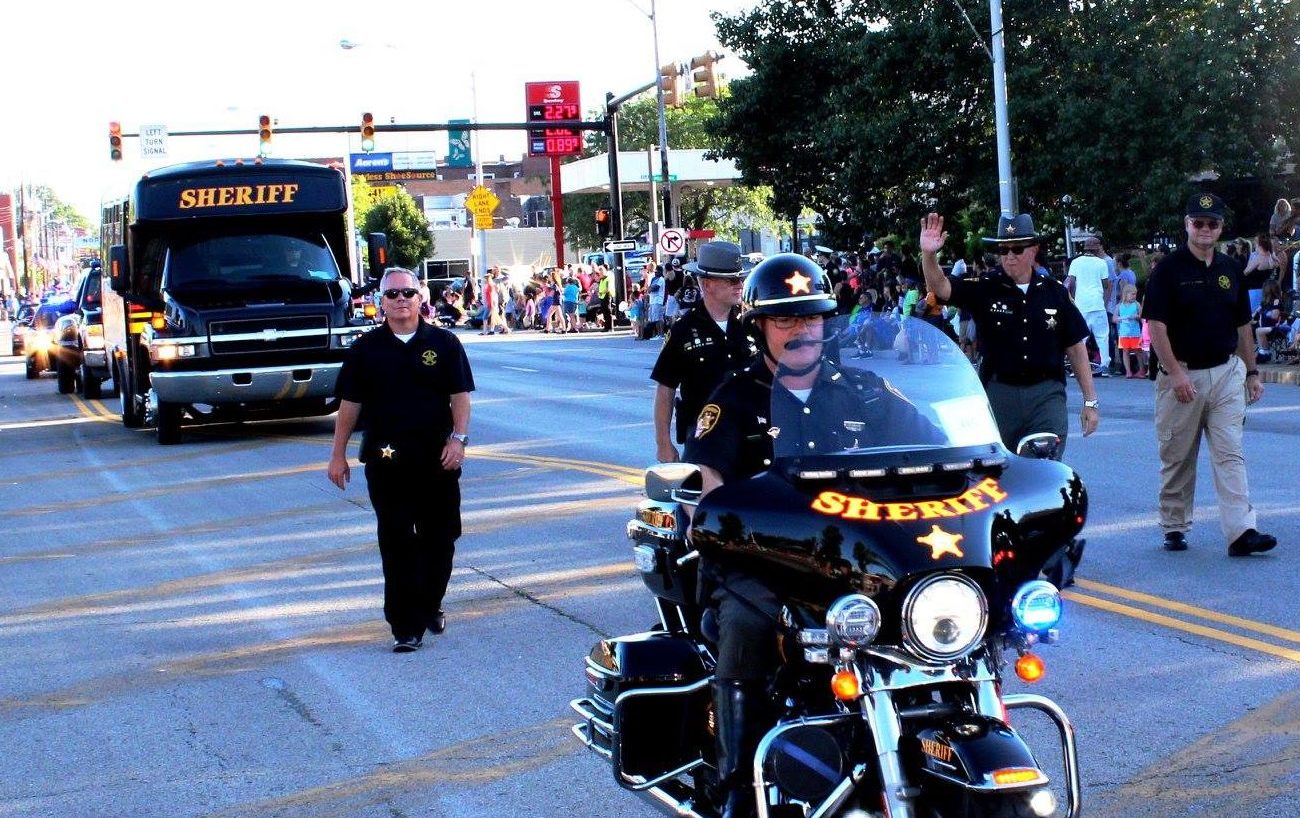Political Report
This Tense Sheriff’s Race Could Change Cincinnati’s Poor Jail Conditions
Ohio advocates are resisting proposals to expand the jail and local cooperation with ICE. In the primary on Tuesday, the sheriff and his challenger disagree on both fronts.

Criminal justice advocates in Ohio’s Hamilton County are resisting proposals to expand county jails as well as local cooperation with ICE. In the sheriff’s race, the incumbent and his primary challenger disagree on both fronts.
Update: Charmaine McGuffey won this primary, after it was rescheduled to April 28 after the novel coronavirus outbreak.
In southwest Ohio’s Hamilton County, home of Cincinnati, a tense Democratic primary between the incumbent sheriff and his former jail director could usher in change for jail conditions.
Results could signal whether voters want to keep county officials focused on reducing the jail population, a goal that is advancing around the country.
Against the backdrop of lawsuits and activist complaints about the local jail, Sheriff Jim Neil and his challenger Charmaine McGuffey differ on key issues that affect the number of incarcerated persons. Among them are whether it’s best to address overcrowding by building a new jail or by pursuing decarceral policies, and whether the jail should continue detaining people when ICE asks it to.
Paul Graham, executive director of the AMOS Project, a local justice nonprofit, believes the election may bring Hamilton County closer to a “vision of policing” that shuns “overpolicing, overarresting, overincarcerating.”
Neil and McGuffey both worked for the sheriff’s office for decades. In 2013, Neil became the county’s first Democratic sheriff in nearly 40 years. He put McGuffey in charge of running the county jail.
That same year, an audit from the state’s Department of Rehabilitation and Correction found that the main county jail, the Hamilton County Justice Center, was failing 48 out of 69 standards, in part because of overcrowding. The inspector referred to the facility as Ohio’s worst jail. By 2016, a new audit found the jail to be compliant with all “essential standards.”
Both candidates take credit for the changes, though advocates say conditions inside the jail continue to be poor.
When she became jail director, a position she held until 2017, McGuffey undertook initiatives to connect people to social service agencies focusing on addiction, mental health, and reintegration upon release. She points to this as proof of the rehabilitative direction she intends to chart if given more power inside the jail as sheriff.
McGuffey says overcrowding was one of the biggest issues, so her department began collaborating with judges to reduce the amount of time people had to spend in the jail. “We started a dialogue with [the judges] asking them to look at their dockets of prisoners and find ways to help us get these prisoners released and move on,” she told The Appeal: Political Report. She added that the jail would occasionally release low-level offenders who were being held on high bonds.
Neil did not respond to requests for comment. David Daughtry, a spokesperson for the jail, said the department had used such methods even before McGuffey was promoted to major, though largely to address particular “spikes” in the jail population.
Overcrowding remains a serious problem in Hamilton County, however. In 2017, a class-action lawsuit alleged that people were held in poor conditions with little space, and forced to sleep on the floor in a “plastic, casket-like shell.” The sheriff’s department has also faced allegations of brutality inside the jail. The county committed to detention caps in a 2018 settlement.
Neil declared a “state of emergency” in 2017 and moved some incarcerated people to a jail in a neighboring county. Recent estimates still put the Justice Center’s average daily population at about 1,400 people, still well above its capacity.
Neil now calls for building a new jail in Hamilton County to address these issues.
This has set up a conflict in the sheriff’s race over whether to prioritize chasing and building more space to detain people, or whether to reduce the number of people detained.
Advocates have said for decades that building new or more expansive jails encourages punitive policing instead of forcing law enforcement to pursue humane, decarceral solutions.
“We don’t need to use [a new jail] to warehouse people,” said Graham. “We can’t incarcerate our way out of social services problems.”
Cincinnati itself is proof of how reforms can eliminate the need for new jails. As previously noted in The Appeal, when the city’s Queensgate Correctional Facility closed in 2008, the number of jail beds in Cincinnati dropped from roughly 2,300 to 1,500. And in the following years, violent crime and property crime continued to decline significantly, as did felony and misdemeanor arrests. Robin S. Engel, a University of Cincinnati criminologist closure, found that the closure was followed by changes in the Cincinnati Police Department’s practices, including not arresting people over minor violations, and partnering with communities to implement strategies of focused deterrence. The police had to think of arrests “as a limited commodity rather than as a standard response,” Engel writes in the study, which was published in 2017.
Neil has given no indication that he intends to change the way that his department polices or approaches arrests. The sheriff’s department polices some townships and municipalities around Cincinnati, a common arrangement.
Instead, in 2018, with the jail well exceeding its capacity, Neil announced that he was exploring plans to reopen Queensgate. In recent interviews with the Cincinnati Enquirer’s editorial board, Neil confirmed that he would support an additional jail.
McGuffey has made clear that she would not. She told The Appeal that Neil believes that “if there’s a new jail [he doesn’t] have to pay attention to it, because now there’s enough room. And I don’t think that is a way to create reform.”
She said that she would prefer to implement decarceral alternatives, such as working to end cash bail for low-level offenses and making sure that people aren’t getting arrested for minor infractions. As one way of ensuring the latter, she is suggesting that the court system is changed so people aren’t issued warrants for being late for a hearing.
Criminal justice reform advocates have pushed for bail changes in Hamilton County.
“We don’t want another jail, because you have people who are just sitting here who need the chance to get out,” Chazidy Bowman, a local reform activist, told the Political Report .
Advocates in Hamilton also point out that Neil has been a no-show at the four candidate forums held by the AMOS Project. Neil “campaigns now on experience, not on being a reformer,” said Graham.
Bowman says she was heartened not only by McGuffey’s presence, but by commitments she made to rethink the system. “She has told us [bail reform] is one of her main focuses, she understands why it’s important, and agreeing that we need it,” Bowman said.
Daughtry replies that Neil is making reforms as he can. In January, Neil instituted a program in which female prisoners could get three days off their sentence for each day they worked for Sweet Cheeks Diaper Bank, a local nonprofit. Neil has also supported efforts to provide medication-assisted treatment to people with substance use issues.
“That’s his way of criminal justice reform,” said Daughtry. “It’s very hard for a sheriff to make these changes, because as sheriff and sheriff’s deputy our role is to enforce the law, not legislate the law.”
Hanging over the race are accusations of misconduct. In 2010, McGuffey was charged with disorderly conduct and public intoxication, though charges were later dropped. She says she was coming out of a gay bar, and that this incident involved anti-gay bias.
In 2017, after facing an internal investigation for creating a hostile work environment, McGuffey declined a lower-paying position and was fired. McGuffey has sued over the circumstances of her departure. She has said the investigation against her was in retaliation over her raising questions about use-of-force incidents inside the jail.
An internal report confirmed that McGuffey had recommended the firing of a sheriff’s deputy for using excessive force against an incarcerated person. Neil and the sheriff’s department have denied that this was related to McGuffey’s demotion.
Whoever wins the primary on Tuesday will face police Lt. Bruce Hoffbauer, the Republican candidate, in the November general election.
McGuffey was endorsed by the Hamilton County Democratic Party in January. The nominating committee’s endorsement of McGuffey was significant because political parties traditionally endorse an incumbent.
Many in the party—particularly those on its nominating committee—remain outraged by Neil’s attendance at a 2016 rally for Donald Trump (he later apologized for going), as well as by his policies surrounding undocumented immigrants.
Neil’s department honors ICE detainer requests, the county jail confirmed to the Political Report. This means that, should ICE request it, the jail will agree to detain someone beyond their scheduled release on suspicions that they are undocumented, giving the federal agency time to apprehend the person. Detainers are administrative requests that are not signed by a judge, and the ACLU of Ohio has argued that enforcing them violates people’s constitutional rights; some sheriffs around the country do not honor them.
McGuffey told the Political Report that she will end the policy should she be elected.
Local activists have protested the sheriff’s department over its ties to ICE. Daughtry strongly denies that the department unduly cooperate with the federal agency. “If they don’t pick [undocumented immigrants] up we let them go,” he said of the aftermath of an ICE detainer. The department sends the fingerprints of people booked in the jail to a federal database as part of the Secure Communities program; Daughtry says there are no other streams of notification. “We do not support, we do not work with ICE,” he added.
McGuffey would not commit to a particular policy beyond ending detainers, though she stressed that she wants to discuss these issues with local activists. “I’m going to follow the law as I am bound to do as the sworn sheriff,” she said. “However there are nuances in our policies and procedures in the jail that give us some room to make decisions that will prevent families from being broken apart.”
For activists in Hamilton County, the conversations that arise because of the primary are a chance to find more receptive ears for jail issues they have long worked on.
“I believe this is how we’ll win bail reform and have a real shift in the criminal justice system,” Graham said.
